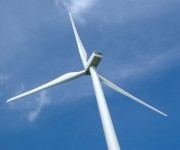A stone marker in Rugby, N.D. identifies the town as the “Geographic Center of the North American Continent.” No marker identifies the state as one of America’s top two or three in wind-power potential. Yet North Dakota’s vast expanses and steady winds endow it with the capacity to generate more than half as much electricity as all 50 states currently produce from all sources combined, according to a recent Harvard study of U.S. wind energy potential.
Indeed, that potential, equivalent to 2.6 trillion kilowatt-hours annually, is almost 100 times greater than the current output of the state’s coal- and lignite-fired generators. And while tapping a goodly share of that capability would require a great many giant turbines — as many as one per several square miles across the state — each tower would only occupy a small footprint, leaving the land largely intact for agriculture and other complementary uses. Jobs erecting the towers and servicing the turbines would be another plus.
So how come wind power accounts for just 2 percent (XLS) of North Dakota’s electricity generation — barely matching wind’s national share? One obvious reason is lack of transmission capability to reach load centers. But another is the extraordinary cheapness of coal.
In 2007 (the last year for which we have data), the coal and lignite burned in North Dakota power plants cost just under a dollar per million Btu, on average. Picture 12 cent a gallon gasoline, and you get a sense of just how inexpensive that coal is, in equivalent-energy terms.
That’s why coal accounts for 93 percent of the state’s power production, and why North Dakota is able to export almost two kilowatt-hours of electricity for every one it consumes — mining, delivering, and burning the stuff is dirt cheap.
Transitioning from coal to wind-powered electricity is probably the biggest single step we can take to dial back our CO2 emissions, and North Dakota and other High Plains states are well-positioned to lead the charge. The best way forward is not to further subsidize wind farms — Washington already does this through the 2.1 cent/kWh production tax credit — but to level the playing field with coal by adding an emissions charge to fossil fuel prices.
You have to marvel, then, at the passivity of the state’s senators in the ongoing debate over climate legislation. As Bill Chameides of Duke’s Nicholas Center on the Environment reported recently, Sen. Kent Conrad has been far more focused on preserving jobs in the state’s oil, gas, and agricultural sectors than in helping wind energy compete with dirty coal. His fellow Democrat, Sen. Bryan Dorgan, has inveighed against the cap-and-trade architecture in the Kerry-Boxer bill, warning that “the Wall Street crowd can’t wait to sink their teeth into a new trillion-dollar trading market in which hedge funds and investment banks would trade and speculate on carbon credits and securities.” Yet Dorgan has offered no alternative means of putting a price on carbon emissions, without which development of wind farms and other clean energy will remain at a snail’s pace.
There is a path to a carbon price without Wall Street speculation, of course, and that’s a carbon tax that’s raised steadily and predictably over time. Distributing the revenues raised by the carbon tax to households on an equal, per capita basis, as Alaska has done for decades with its North Slope oil revenues, would protect families against the rise in energy prices and also ensure that “big government” gets no bigger — both major concerns in the Plains States as elsewhere.
A revenue-neutral carbon tax, or carbon fee-and-dividend as some prefer to call it, would seem to be just the ticket for Senators from wind-rich states who rightly fear climate change and market speculation. North and South Dakota both celebrated their 120th anniversary last week as members of the union. What better way to harken back to that independent pioneer spirit than to spit in the face of the special interests and help a revenue-neutral carbon tax win a place in the national climate policy debate?



